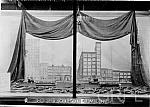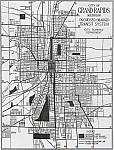
Grand Rapids Streetcars
by Michael Knopf, GVSU Student
published: May 10th, 2008
Rail tracks crisscrossed the country in the era before the automobile. Even in the cities rail tracks provided the dominant mode of transportation. By the 1900’s streetcars that rode on those tracks made urban life possible, and before the automobile’s momentum became unstoppable, streetcars were seen as essential for any city. Grand Rapids had its own distinguished streetcar history. A horse-drawn carriage actually rode along the tracks built by Grand Rapids in 1865. The city would experiment with a variety of streetcar types, including a steam driven car and a cable car line similar to the cable cars of San Francisco. By far the most important innovative period in Grand Rapids though, began in 1926 with the arrival of the Grand Rapids Electric Coach. For the next nine years Grand Rapids had the most modern streetcar system in the entire country until it was disbanded in 1935. The following pictures give a glimpse into the past when cities rode on rails. (Find more information to your right in Related Items)
Grand Rapids was famous for personalizing its streetcars. The streetcar, the Spirit of St. Louis, was named in honor of a visit to Grand Rapids by Charles Lindberg. Even by 1920 automobiles were costing the streetcar company money and flashy streetcars were an easy way to advertise.
Another example of personalized streetcars was the Campfire Girls' car. This car was the counterpart to the Boy Scouts' car, both of which were very popular. Scouts would stand at attention whenever the car rolled by. Special cars like this were only part of a massive advertising campaign, one of the first such campaigns of the century. One of the most popular advertising techniques involved hiring young models to sit atop the cars with signs that read, "Don’t worry relax! Ride the streetcar; it's the safest place in town!"
Here's a typical interior of the old-style streetcars. These cars had a reputation for being noisy and uncomfortable. One newspaper not so affectionately referred to the old models as "old noisy rattletraps."
The interior of the "Grand Rapids Electric Coach" depicts a more comfortable car. The new model was designed after the city held a competition for the three largest streetcar manufacturers in the country to produce the most modern streetcar. Riders were then asked to vote on everything from their favorite colors to the seat design and lighting. The final design was a combination of all three models and was considered to be a great success.
The leadership of the Grand Rapids Railway Company stands in front of one of their cars in the early 20's. Among them is Louis J. DeLamarter, who started as a theater worker at Ramona Park in East Grand Rapids. His talents were quickly realized and he was promoted to General Manager in 1920. DeLamarter was personally responsible for the company’s attempt to modernize in the mid 1920s. It began after a fire at one of the company's car barns destroyed 57 streetcars. DeLamarter decided to use the insurance funds he received to develop a new generation of streetcars.
Anticipation for the new design was evident in shops throughout the city where residents could get a glimpse of the new streetcars. Herpolsheimer's window display shows a model of the new streetcars.
A parade of streetcars brought out crowds on June 12, 1926, perhaps the grandest event in the city's entire streetcar history. Twenty-seven new streetcars were unveiled at the same time to the public while a marching band played. City leaders praised the visionary leadership of Louis J. DeLamarter, the general manager of the Grand Rapids Railway Co. Most people expected that streetcars would remain essential for all cities well into the future.
A week after the parade through downtown Grand Rapids 50,000 people crowded into the West Michigan Fairgrounds to see the end of the old streetcars. Twenty old cars were primed with kerosene, hay, and black powder. While fireworks exploded into the air the cars were set ablaze. It was a symbolic gesture signifying the end of the old and the beginning of the new. In an ironic twist, the streetcar would only remain a part of Grand Rapids life for another nine years when the last tracks were torn from the ground.
An artist's drawing in 1927, conceptualizes the appearance of Grand Rapids in 1975. The plan involved reorganizing the entire track system upon which the streetcars ran to better serve the city. It also involved widening the city streets so that cars could travel in them easier. Furthermore, the plan proposed the construction of a large terminal in the center of downtown to connect the city's streetcars with the larger interurban network--commuter trains that connected regional cities together. Despite the popularity of the automobile, city planners still felt that streetcars would remain a part of urban life for some time to come.
In the old days competing streetcar companies laid tracks without considering the long term situation, so many areas of the city were not served by the streetcars. This resulted in a loss of profits for the Railway Company which struggled financially for many years. By reorganizing the layout of rails the company hoped to win back more riders while convincing others that automobiles were unnecessary. The map shows the proposed reorganization of the city's rail lines.
's. When the Great Depression began in 1929, money that was planned to support the streetcar network was diverted to other matters. After struggling for years, the Railway Company decided to abandon its fleet of streetcars and replace them entirely with buses. Other cities followed the same path soon afterwards, and by the end of World War II nearly every major city in the country relied solely on buses for public transportation.

"Glance at the Past" is a collaboration between the Community Media Center and the Grand Rapids Historical Commission. Today's episode tells of Grand Rapids as a national leader in streetcar transportation.
Bibliography
Items Available in the History and Special Collections Dept. of the GRPL
- Baxter, Albert. History of the City of Grand Rapids, Michigan. New York, Grand Rapids: Munsell & company, 1891.
- Goss, Dwight. History of Grand Rapids and its Industries. Chicago: C. F. Cooper, 1906.
- Lydens, Z. Z. The Story of Grand Rapids. Grand Rapids: Kregel Publications, 1966.
- Electric Railways of Michigan. Central Electric Railfans Association, 1959.
- The White Printing Company’s Street and Railway Service Directory of Grand Rapids, Michigan. Grand Rapids: White Printing Co., 1914.
- Trolley Topics, Collection #035
- Grand Rapids Railway Co., Collection #105
Books Available at the Grand Rapids Public Library
- Middleton, William D. The Time of the Trolley. Milwaukee: Kalmback Pub. Co., 1967
- Molloy, Scott. Trolley Wars: Streetcar Workers on the Line. Washington, DC: Smithsonian Institution Press, 1996.
- Rowsome, Frank. Trolley Car Treasury: A Century of American Streetcars, Horsecars, Cable Cars, Interurbans, and Trolleys. New York: McGraw-Hill, 1956.












 facebook
facebook


